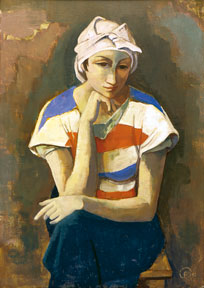Karl Hofer, The contemplative woman, 1936

This notion of humanity was not in keeping with 1936, the year in which the Olympic Games were staged in Berlin amid jingoistic propaganda campaigns throughout Nazi Germany. Karl Hofer had already been dismissed from his position as professor at the University of Fine Arts in Berlin in 1934; more than 300 of his works were later removed from public collections for being 'degenerate'.
Hofer's artistic focus was on the development of universal, timeless forms. He therefore erased all traces of individuality from his portraits, preferring instead clear compositions and tectonic structures. Hofer remained true to his classic-idealistic notion of the figure into the 1950s, continuing, as an artistic loner, to focus on his image of humankind.